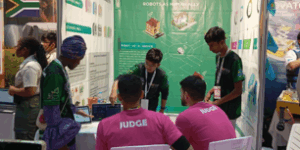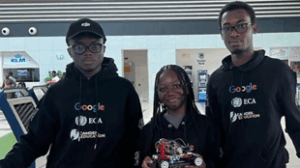By Michael WILSON(Dr)
Let’s face it. Research doesn’t start in a lab, surrounded by people in white coats mumbling about control variables and chromatography. It starts with a toddler trying not to fall. Seriously. That wobbly balancing act? It’s an open-field experiment in Newtonian physics.
And just like that, we all begin life as researchers, not students. Wonder, curiosity, experimentation is hard-coded into the human operating system. But here’s the problem: somewhere between learning to walk and being told to sit still and memorize the periodic table, we kill it.
The current educational framework, especially within middle and high schools, operates using obsolete software that is rigidly declarative, propositional, and inflexibly static. This approach prioritizes memorization over exploration. Students move through this system as they’re inundated with information yet deprived of curiosity. This isn’t true education; rather, it resembles mere data input.
If we’re truly committed to nurturing the next wave of scientists, inventors, and indeed the odd rebellious prodigy, then we must change our entire approach. It’s high time we move away from cramming information into students’ heads and instead ignite their curiosity and critical thinking skills.
At the Electronics Division of the Council for Scientific and Industrial Research – Institute for Scientific and Technological Information (CSIR-INSTI), we didn’t just complain about the system. We rewrote the code using our Junior Researcher Programme (JRP)
Join the Junior Researcher Programme (JRP) – Consider JRP as research preschool where junior and senior high school pupils team up with experienced researchers to address real-world issues rather than theoretical scenarios concocted in old textbooks.
These young participants aren’t just simulating scientific work; they’re actively engaging in real research. Over the past year, more than 60 students participated. The group was split into three age groups: elementary, middle school, and high school levels. They dove deep into projects focused on addressing issues like food scarcity, enhancing urban sustainability, and developing autonomous mapping technologies.
Let me introduce you to two of the standout projects that didn’t just impress local judges but also competed on the world stage at the World Robot Olympiad in Izmir, Türkiye, under the Ghana Robotics Academy Foundation’s banner.
Project 1: Intelligent garden surveillance bot – the Green Guardians
Introduce Rehan Ashfaq, Aneesh Dupaguntla, and Enam Bani — aged between 13 and 15 — creators of RAPGO (Robotic-Assisted Precision Garden Orchestration). In a nation where families with average incomes allocate 30-50 percent of their income towards food expenses, this project isn’t merely an impressive abbreviation; it represents hope.
Their initiative transforms idle backyards in Ghana into productive areas through the use of smart soil sensors linked to Internet of Things (IoT) edge devices. Once environmental parameters fall below optimal levels, a built-in robotic mechanism collects current information and springs into action—dispensing nutrients, removing unwanted plants, and enhancing overall garden vitality. These young individuals have been tackling issues like food safety, sustainable city living, and financial self-sufficiency long before reaching voting age.

Their approach tackles all eight major Sustainable Development Goals (SDGs) simultaneously—from combating climate change to eliminating hunger—quite impressive considering this initiative began at a junior researcher workshop.
Project 2: Self-navigating ground vehicles using SLAM – Mapping our future
In the meantime, Muhammad Nurul Haqq Munagah, Edwina Frances Kate Mensah, and Jonathan Darko Adoo from the senior division were also making significant progress. They developed an Autonomous Ground Vehicle (AGV) equipped with Simultaneous Localization and Mapping (SLAM), utilizing RPLIDAR technology along with Intel’s D435i depth camera. In simpler terms, this means their vehicle has the capability to perceive its environment, process information independently, and move autonomously without external guidance.
Why does this matter? Think precision agriculture, search and rescue, ecological monitoring and any place where humans either can’t or shouldn’t go. The fusion of LIDAR and camera data gives these AGVs real-time environmental awareness, enabling hyper-accurate mapping in even the trickiest terrains.
This goes beyond simple toy robotics; it involves advanced multisensor integration research. The remarkable aspect of this work—being carried out by students aged 16-21—should underscore the immense potential still waiting to be unlocked within our educational systems.
From boot camp to benchmarks – shifting gears from fundamental to practical research
Here’s the key point: These initiatives were not just isolated science fair projects. They have since been incorporated into CSIR-INSTI’s core research framework. As for the intelligent gardening venture, it has advanced to applied research status and is now part of our AgriSense Hub—a cutting-edge platform focused on plant phenotype analysis and crop data management.
We’re utilizing this project to gather data, tag information, and educate AI systems for precise agricultural practices. Indeed, children are actively contributing to shaping the future of Ghana’s food production ecosystem. The primary aim of the JRP is straightforward: foster scientific minds rather than merely producing pupils.
By means of mentoring, practical projects, and aligning with the CSIR’s key research areas, we’re developing a talent pool that benefits not only Ghana but also has an impact globally.
Our partners – it truly does take a village.
None of this happens in a vacuum. We’ve had critical support from CITSYS Limited, The Responsible AI Lab at KNUST, the Mikrobot Academy and the tireless evangelists at the Ghana Robotics Academy Foundation.
Together, we’re proving what happens when you give young people tools, mentorship, and most importantly, permission to explore.
Next time you encounter someone saying “young people nowadays can’t tear themselves away from their devices,” point out: indeed they do spend quite a bit of time engaged with their screens.
However, some individuals are employing these screens to develop prototypes aimed at addressing climate change. The future is reserved for the inquisitive. Our task is simply to avoid stifling their curiosity.
The author leads the Electronics Division at CSIR-INSTI and additionally dedicates time as the chief trainer for the Ghana Robotics Academy Foundation. Over the past ten years, he has been involved in educating children to engage their minds, experiment with ideas, and construct innovative projects.
Provided by Syndigate Media Inc. (
Syndigate.info
).


